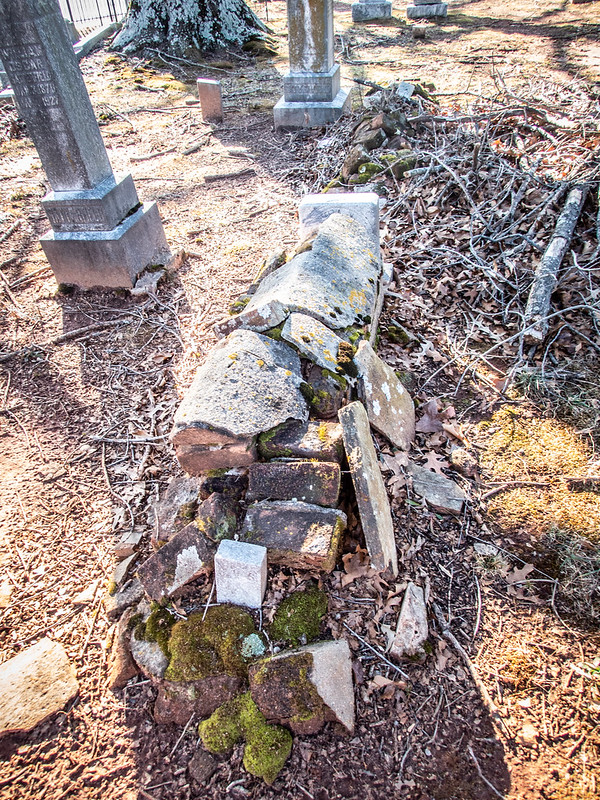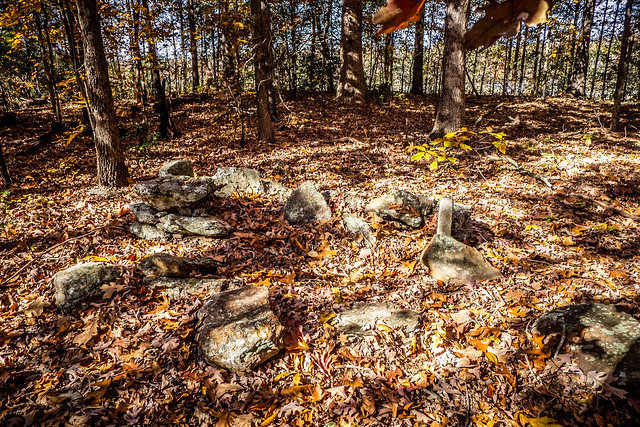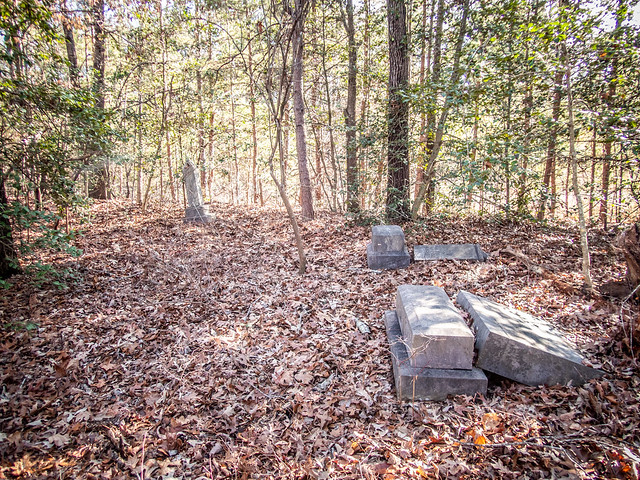Salem United Methodist Church sits prominently on White Horse Road, right where it intersects with I-185 on the west side of Greenville. The church has a history with our family. From 1963 until 1976 its pastor was the Rev. Bill Cooke. My brother, Stephen, and Bill’s daughter, Cynthia Cooke were married in the church in the late 1970s.
Apart from the Cooke connection I didn’t know too much about Salem. I kind of took it for granted as just one more of the many churches on every corner of Greenville. As is typical with mid-20th Century churches, this is a brick edifice in classical architecture with a steeple. It even has its own historic graveyard with Civil War soldiers and many old headstones.
That’s why it came as a surprise to me that the church was originally located several miles away and that an even older, hidden graveyard marked that first location.
I found the cemetery through Find-a-Grave listed as “Old Salem United Methosidt [sic] Church Cemetery”. I added it to my list of orphaned graveyards before I discovered its link to present-day Salem Methodist.
The first time I visited the graveyard was back in November of 2019, over a year ago. I followed my GPS through parts of Western Greenville with which I was not familiar. My route took me to a frontage road next to I-85 where I found a gate barring further progress.
I parked at the side of the road and the GPS led me to the area between the frontage road and Interstate. There were some old wooden and tin roof structures and what looked like an old roadway leading past them.
Further west I finally found the cemetery, or what was left of it. There was a stone wall surrounding a single headstone. Not exactly what I’d call a cemetery, but it was right where it should be.
On this trip I could only find a couple of stones actually standing but they seemed to mark the same grave. These had writing that was mostly illegible. It looked like there were more graves in the area, either marked with field stones or completely unmarked.
Find-a-Grave has listings for only two graves, that of Mary E. Payne and Sarah Spoon. These were NOT the ones I found on my initial trip. Sarah Spoon’s headstone is a small obelisk, while Mary Payne’s is a slab. Both are very legible. On my first visit I completely missed these headstones, but on my return trip today I was able to find these graves, as well as several others.
The headstones I’d found previously seemed a bit more legible.
I could clearly make out the initials “J. W. S.” on one stone and the name “John W. Satterfield” on another. Satterfield was only an infant when he died.
One other thing I noticed on this trip was that security had been beefed up considerably. The piecemeal barricade I’d encountered on my first visit had been replaced with something much more substantial. There were now “No Trespassing” signs, as well as signs indicating that security cameras were in use.
I wasn’t sure what was being secured. The land on either side of the road? The road beyond? The land to the south was posted, but not the land on the other side of the road, where the cemetery was. I checked the Greenville County GIS map and it indicated that the cemetery land is now owned by Salem Methodist, having reverted back to their ownership relatively recently in 1992.
While the Salem plot looked well-kept, the plot to the east had an old shack and some trash.
So that’s what’s here now. What was it like when this was frontier? I found some information on the church’s website…
Salem Methodist Church was the direct outgrowth of the work of Bishop Francis Asbury. In 1813, Bishop Asbury established a prayer meeting that continued until 1836. In this year, the Salem Church was organized as a result of the prayer meeting begun by the great pioneer preacher twenty-three years earlier.
The site of the original Salem Church was on the Aaron Payne place near Stanton Bridge about five miles from Greenville. The location of the church was moved to its present location, 2700 White Horse Road, in 1850.
The present sanctuary was built in 1951 and the current educational building was consecrated April 7, 1968. The Family Life Center was dedicated November 30, 1986.
Salem United Methodist Church – About Us
A researcher on the Roots Web website has a similar history…
Our church is a direct outgrowth of the work of Bishop Francis Asbury. In 1813, while a guest in the home of Mary and Harriet Payne, Bishop Asbury conducted Salem’s first prayer service which continued until 1836, the year that Salem Church was organized. The original site of the church was near the Saluda River and Highway 291 where it passes to the rear of White Horse Mills on the Aaron Payne place near Stanton Bridge. Salem was one of ten churches making up the Greenville circuit in 1836. After a number of years the location of the church was moved to a new site near White Horse Road. In 1850, it was moved to its third and present location at 2700 Whitehorse Road.
In 1951, our present church sanctuary was constructed and the old building was used for the Sunday School. Since its beginning Salem had been on a charge, but in 1964 Salem became a station church. In 1967, the old Sunday School Building (constructed in 1850) was dismantled and construction on the present Education Building began. In 1986, the James R. Gregg’s Family Life Center was consecrated.
Salem continues to be a church with deep roots, but also looking forward to even better days to come.
Paul M. Kankula, SC Genweb Project, 1999
So the congregation formed in 1813 under the auspices of Francis Asbury and the first church was constructed in 1836.
In 1850 the congregation moved to a five acre plot on White Horse Road, where another wood-frame structure was built.
One hundred years later the wood frame building was dismantle, to be replaced with the present sanctuary.
The surname “Payne” appears in both of these historical accounts. I was curious about the Payne family and the area in general. Present-day Staunton Bridge Road runs from White Horse Road to the Old Salem location. Try as I might, I couldn’t find an extant “Staunton Bridge” across the Saluda River. When I started digging into this I found multiple spellings for both Staunton (Stanton, Stauton) and for Payne (Pain). Robert Mills’s 1825 map of Greenville District shows a “Pain’s Mill” located immediately downstream from Stanton’s Bridge.
The kind folks at the South Carolina Room of the Greenville Library pulled some information for me that answered a few of my questions. A history of the Payne family indicates that they came to South Carolina from Maryland down the Great Wagon Road. The Stantons were the other prominent family in the area, and I found several instances of Paynes marrying Stantons. Somehow over the years Stanton changed to Staunton (sort of like how Richard Pearis’s name got changed to “Paris” when they named the mountain.) Traffic was rerouted to Dunham’s Bridge to the north and Staunton’s Bridge was lost to history. I couldn’t find when that happened.
Then there’s the question of Mary Payne. Her headstone shows that she died in 1920. This kind of messes things up as far as the timeline for the church is concerned. Salem has been in its present location since the mid-1800s. That means both Payne and Sarah Spoon’s early 1900s burials are a bit out of place. They should have been buried in the current Salem graveyard.
I found Mary Payne’s obituary from 1920 in The Greenville News. It states that she was buried in “the Payne burying ground.”
The Payne headstones I found were later, and they did seem apart from the older headstones. The church started on the Payne farm, so it’s possible that they set aside a plot for the family.
However, not all Paynes chose to be buried at Old Salem. The Payne family remained active in the Salem congregation and I found several headstones with that surname in the present graveyard.
Conclusions
Is Old Salem Graveyard an orphan?
I would say yes. The church moved away and the graveyard has been neglected for over a hundred years. It has even been replaced by a newer graveyard, albeit one that’s now a hundred and seventy years old itself. However, Salem Methodist is still a very active congregation and still operating under the same name since 1836. With the reacquisition of the the land around the old cemetery it’s possible that they plan to reclaim, or at least maintain it. I hope that they can bring more attention to this lost part of their heritage.









































I enjoy reading your blog. Glad to see your back posting. This reminds me of Tabernacle Cemetery in Calhoun County.